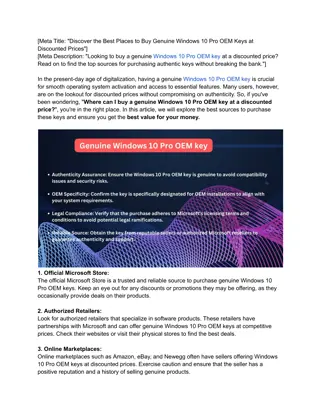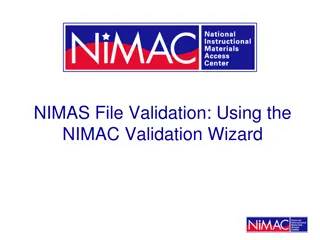Streamlining OEM Validation Process at Intel: A Comprehensive Overview
Abstractable library offers a simplified approach for OEM validation test cases at Intel. The history and present validation practices, including an example test case, phases like analysis and design, provide insights into the process. The content delves into setting up the Integrated Test Environment (ITE) on devices under test (DUTs) to enhance testing efficiency and bug detection prior to shipping to OEMs.
Download Presentation

Please find below an Image/Link to download the presentation.
The content on the website is provided AS IS for your information and personal use only. It may not be sold, licensed, or shared on other websites without obtaining consent from the author. Download presentation by click this link. If you encounter any issues during the download, it is possible that the publisher has removed the file from their server.
E N D
Presentation Transcript
OEM Validation Library Nicole Ross Real World Project for Intel
1.1 Introduction Abstractable Library to use in all OEM validation Test Case s Attach this library to any OEM Test Case and your automation process is simplified and more organized.
1.2 OEM Validation History Intel would do a set number of iterations of specific test cases Then the wireless card would be release to OEM to do their validation. Bugs would be found that went undetected on Intel s side. OEM s would report there bugs and we would run more specific test cases on that equipment.
1.3 OEM Present Validation New group at Intel Created to OEM validations and bugs. OEM validation is done before shipping to OEM s and bug investigation is done. Many test cases follow a similar pattern Same functionality needed Create a library to use on all test cases Save time, that is what programming is for.
2.0 Phase 1 2.1.1 Analysis Figure out what library would do Gather tools and equipment Server Switches Cables Test DUT s (device under test) Access Points Power Distribution Unit Misc. equipment to implement the lab.
2.1.1 Analysis Continued Learn what ITE was: Integrated Test Environment Set up ITE on DUT s Learn VB Do test manually first.
2.1.2 Setup Ghost Setup DUT s with same Win7 images Create an image and load images Images had ITE on them Updated ITE 3 times with new releases Set up a physical network Adam Jacques (Batman) and John Marra Switches, AP s, PDU s, Server SVN Repository Getting ITE to Work !#$~)($^
2.2 Phase 2 2.2.1 Design Understand what, now How? Use of appropriate file hierarchy Functions in appropriate files and folders Make functions abstractable Made to be used in all OEM Test Cases Developed a pattern to follow for structure in each function
2.2.1 Design Continued Drew pictures to understand the relationship between functions, files, and directories in the library. Build a skeleton first empty files and functions. Taking time in this phase helped reduce stress in the coding phase More ITE stumbles!!!!!!!!!!
2.3 Phase 3 2.3.1 Coding VB Easy language hard to implement an API that you have little to no docs. Code then test. Good and bad input. Expect good input to pass & Bad to fail. Looks easy (not the case). Problems and Solutions created.
Example Function in WiFi_Profile Function CreateAdhocNetworkWPAAES (DUT, SSID, WPAkey) DUT.Profile.DeleteAllProfiles() Dim dutCreateProfile Set dutCreateProfile = DUT.Profile.CreateProfile.WPA.Personal.AES(SSID,SSID, WPAkey, 1 ,2) If Not dutCreateProfile.Passed Then ITE.TestLog.Results.Error "Failed to create an Ad-Hoc Network on DUT: " & dutCreateProfile.Description Exit Function End If Dim dutConnectProfile Set dutConnectProfile = DUT.Profile.ConnectProfile(SSID) If Not dutConnectProfile.Passed Then ITE.TestLog.Results.Error "Failed to connect DUT to Ad-Hoc Network: " & dutConnectProfile.Description Exit Function End If ITE.TestLog.Results.Pass "Successfully Created Adhoc Network with WPA/AES." End Function.
2.4 Phase 4 2.4.1 Test Test functionality after creation Created an extra phase dedicated to testing before it was shipped. Used good and bad parameters
2.4.2 Troubles Iperf functions could not fail Is 0 a valid IP? Passes if it runs, great! (who cares if it really works) Learned Wireshark to trouble shoot traffic. Traffic was being send over Ethernet. Created multiple functions to use for testing. These can be used as an analysis tool. It's all a blur. Like a horrible day-mare. -Robin
2.5 Phase 5 Release - Evaluation And we find our selves here. Two customers to please. OEM Team lead was impressed. Munir was pleased.
Release and Evaluation Continued Intel is currently using it. Lab will continue to use it and improve Hard to improve what is already perfect Change variable names to mirror Intel s OEM groups automation. (doing currently) Gear it more towards changing Test Cases Add new technologies BT 4.0 WiFi Direct WiDi *** New lab on campus.
Considerations For The Future May consider developing an additional library to harbor functions to help new technologies. Another library for Analysis functions A tool to analyze throughput Statistical information Get the date, report, and do something with findings.
3.0 Reason For Choosing Project All the things I could learn Fill some gaps that are necessary for my new position. Enterprise Application Engineering as Performance Engineer/Analyst. Real World Project Customer expectations Deadlines Communicate success and failures
Reasons For Choosing Project Cont. Truly believe in making things better. Improve products to exceed other manufacturers. Meet customers expectations. Went to many meetings at Intel Met Munir Discussed projects, this being one
4.0 Topics Learned Cont. Technologies & Terminology? Cisco OS calls Networking protocols and terminology Add-Hoc Programmable switch Iperf Collaboration with client over want, needs, and timeline Code under someone else's specifications Comment under someone else's specifications To implement Robo Doc
4.0 Topics Learned Cont. VB regExpParseString - regular expressions are not that easy in VB Wait () to allow other functions to catch up before preceding Switched Rack Power Distribution Unit Wireshark packet sniffing Code version control using SVN repository Creating a repository on server Comparing versions Organizing Repo
4.0 Topics Learned Cont. Corporate Coding guidelines Effective use of creating a timeline for a project that will continue after my departure Utilizing abstraction layers Validation Engineering Building test cases from scratch AP programming Learning Cisco's AP system calls
4.0 Topics Learned Cont. APC Switched Rack Power Distribution Unit (PDU) How to set up from scratch How to set up from a previous installation (much harder) Local configuration as opposed to networked configuration Read a lot of the user guide for command line interface Needed to learn how to send command line commands to the PDU using telnet through Another program
5.0 Conclusion Very happy with project Topics learned Progress made Would have liked more hand-on Focus on wrappers and abstraction dev. Communication























